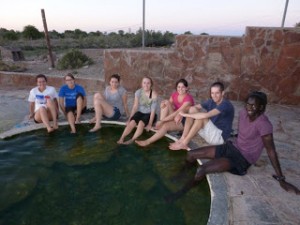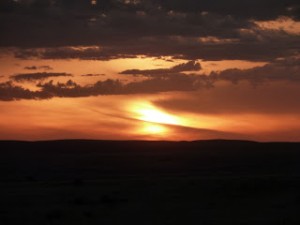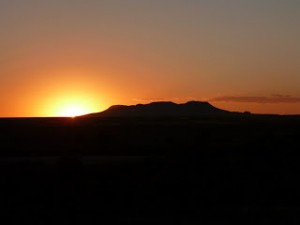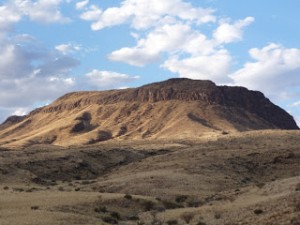So while in Namibia we took a short trip to the south where we examined community-based resource management. It was exciting that we’ve now seen nearly every corner of Namibia. Also, while learning Khoekhoegowab this semester (the language of our rural host family) we had high school students come and tutor us. The language is a compilation of Damara (spoken in the Khorixas area) and Nama (a language spoken in the south) and some of the students were from this area, so it was interesting to see where they were from. Our main purpose though was to compare some of the areas that are trying to implement programs similar to the ones Namibia has won awards for and some challenges they are facing.
Namibia has been praised internationally for its successful conservation programs and just last month, Namibia was awarded the Markhor Award for the conservation of biological diversity and human livelihoods by the International Council for Game and Wildlife Conservation. The award was presented at the 11th annual United Nations Biodiversity Conference in India.
During apartheid, land was owned predominately by whites, forcing black Namibians onto small plots of land with few resources or animals. The only way for many of these farmers to survive was through poaching. Poaching intensified during the 70s and 80s amid drought and war, resulting in a near extinction of many animals.
In the 90s, Namibia thought of a way to turn poachers into gamekeepers by shifting to a policy of community-based resource management, where farmers live hand-in-hand with wildlife in designated conservancies.
The programs have been very successful in the northwest Kunene region where Hartmann’s mountain zebra numbers have grown to 27,000 from only 1,000 in 1982. Namibia has the largest black rhino population in the world, and the number of desert-adapted elephants is five times higher than in 1982.
 The combined total earnings of Namibia’s conservancies total more than US$4.8 million, derived mainly from trophy hunting and tourism. Private-public partnerships are at the heart of the program’s success in places like the Torra conservancy in northwest Namibia, where the private Damaraland Camp pays rent to the conservancy and hires locals in exchange for running a luxury lodge that brings in large-scale tourism, job creation, marketing, and training for local employees.
The combined total earnings of Namibia’s conservancies total more than US$4.8 million, derived mainly from trophy hunting and tourism. Private-public partnerships are at the heart of the program’s success in places like the Torra conservancy in northwest Namibia, where the private Damaraland Camp pays rent to the conservancy and hires locals in exchange for running a luxury lodge that brings in large-scale tourism, job creation, marketing, and training for local employees.
Conservancies in the south seem to be in a very different situation than those in the north, however, as we learned on our travel seminar this weekend. Mr. Davids, a former employee of the Namibian Development Trust (NDT), told our group that conservancies in the south struggle to sustain themselves without the big-5 game animals. The money southern conservancies do make, which is roughly US$11,400 goes directly to operational costs.
The Ganigobes community campsite where we stayed one night in southern Namibia began as a project of the NDT back in 2007. Since its inauguration in 2010, the campsite has only had 2 overnight groups (both CGE groups). They are also struggling to get plumbing set up due to government and money-related issues.
The program has since lost its EU funding, and the NDT has been forced to close down as well. Without funding, the campsite struggles to market itself. In order to just put up a road sign, they need to be registered with the Namibian Tourism Board, which can take ages to accomplish with all the bureaucracy it entails.
The community in Ganigobes is in the process of applying for conservancy status in hopes that as a conservancy, the community will be able to buy game animals at a cheaper rate to attract more visitors to the area. Even with more springbok and ostriches, the Ganigobes community still lacks the big-5 animals and is not likely to prosper to the extent of Namibia’s northern conservancies without government funding or support from private-partnerships with the already-established luxury resorts in the region.
Regardless, the Ganigobes campsite, as well as the Brukkaros campsite where we stayed our second night, are both beautiful. The landscape is gorgeous and the sunsets are breathtaking. Ganigobes has a hot spring and a view of the mountain. They also have drinking water, but no plumbing. The Brukkaros campsite does not have water, but it situated right at the base of the mountain, so if you like hiking, be sure to check it out! We spent our third night at a private lodge near Mariental, Namibia. They have indoor lodges with showers, electricity, etc. but they also have very nice campsites with electricity, showers, toilets, and a kitchen area (just tables, shelves, and a sink).
 While the private lodge was very nice, it did not have the same hiking or breathtaking landscape. The lodge is perfect for the traditional Namibian tourist, eager to set out on a game safari drive or lounge by the pool and drink at the bar. I enjoyed all three sites, and while the third lodge has the ‘comforts of home,’ I still enjoy the occasional rustic camping trip to the community sites where you can be left alone in nature without the distractions of other loud tourists.
While the private lodge was very nice, it did not have the same hiking or breathtaking landscape. The lodge is perfect for the traditional Namibian tourist, eager to set out on a game safari drive or lounge by the pool and drink at the bar. I enjoyed all three sites, and while the third lodge has the ‘comforts of home,’ I still enjoy the occasional rustic camping trip to the community sites where you can be left alone in nature without the distractions of other loud tourists.
But that is not to say the lodge was not very enjoyable – even though they are not community-run, they still were very adamant about incorporating wildlife conservancy and sustainable ecotourism into their business model, which I found very refreshing! The lodge also offers internships to Namibian tourism students and gives back to schools in the community. The staff are well trained in eco-tourism and wildlife conservation…I am not sure whether members at the community campsites are given the same type of training in conservation…
If you are interested in reading more about Namibia’s conservation programs, feel free to check out Janessa Schilmoeller’s related article: http://www.mintpress.net/is-namibias-internationally-acclaimed-conservancy-model-a-cookie-cutter-for-development/


Leave a Reply